Baqsimi nasal spray is a life-saving treatment for severe hypoglycemia, delivering a 3 mg glucagon dose through the nose without an injection. It works within about 15 minutes and is designed for quick use by caregivers during emergencies. Understanding proper usage before an emergency happens is crucial for you and your caregivers.
This guide covers everything from recognizing when to use Baqsimi to proper storage and handling, ensuring you’re prepared when severe hypoglycemia strikes.
Key Takeaways
- Baqsimi delivers glucagon powder via one nostril—no inhaling required.
- To use: open the tube, insert the tip in one nostril, and press plunger until green line disappears.
- Call emergency services immediately after giving Baqsimi, even if symptoms improve.
- Common side effects: nausea, vomiting, runny/stuffy nose, watery eyes.
- Store below 86°F (30°C), keep sealed until use, and replace after expiration.
Table of Contents
What Is Baqsimi Nasal Spray and How Does It Work?
Baqsimi is a dry nasal powder containing glucagon that treats severe low blood sugar emergencies in people with diabetes. It works by activating liver receptors to quickly raise blood glucose levels during dangerous hypoglycemia.
Developed by Eli Lilly and approved by the FDA in July 2019, Baqsimi is the first non-injectable glucagon treatment. Delivered as a single-use nasal spray, it comes ready to use with no mixing or preparation required.
Key Features
- Single-dose nasal device
- No injection required
- Ready to use without mixing
- Works for adults and children 1 year and older
Storage Guidelines:
- Store Baqsimi below 86°F (30°C) in its original shrink-wrapped tube until use
- Do not open the tube until ready to use. If the tube has been opened it could be exposed to moisture and not work as expected.
- Replace before expiration date
Step-by-Step Instructions for Using Baqsimi Nasal Spray
Using Baqsimi nasal spray requires proper preparation before emergencies occur and following specific steps during administration. The device delivers a 3 mg dose of glucagon through the nose to raise blood sugar levels quickly during severe hypoglycemia episodes.
Preparation Before an Emergency
You must read the Instructions for Use before using Baqsimi and keep the device accessible at all times. Tell your family, friends, and caregivers where you store your Baqsimi device.
Show them exactly how to use the nasal spray before an emergency happens. They need to understand that Baqsimi treats very low blood sugar and that insulin should never be given during these episodes.
The device can be kept wherever it may be needed including at work, school, or while traveling. Make sure multiple people know the location and can access it quickly.
1. Remove the Shrink Wrap
Remove the shrink wrap by pulling the red stripe when you’re ready to give the dose. Open the lid and take out the Baqsimi device from the tube.
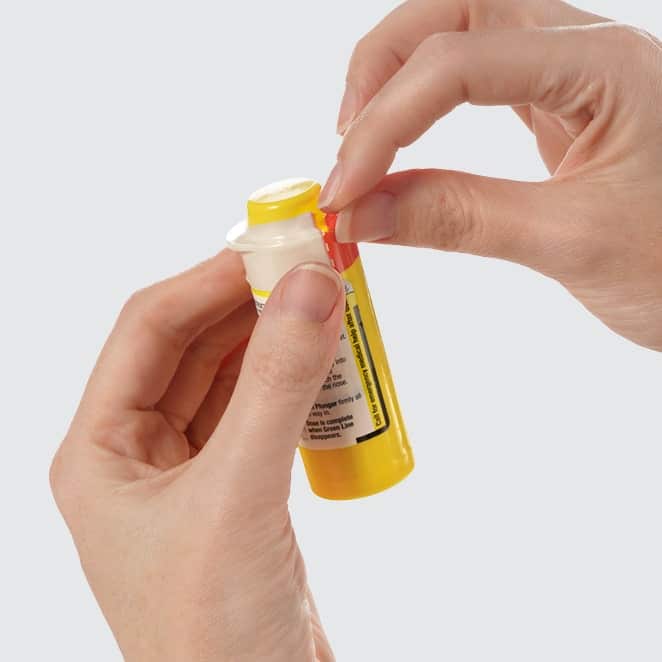
2. Open the Lid
Open the lid, remove the device from the tube, and avoid pressing the plunger until you are ready to give the dose.
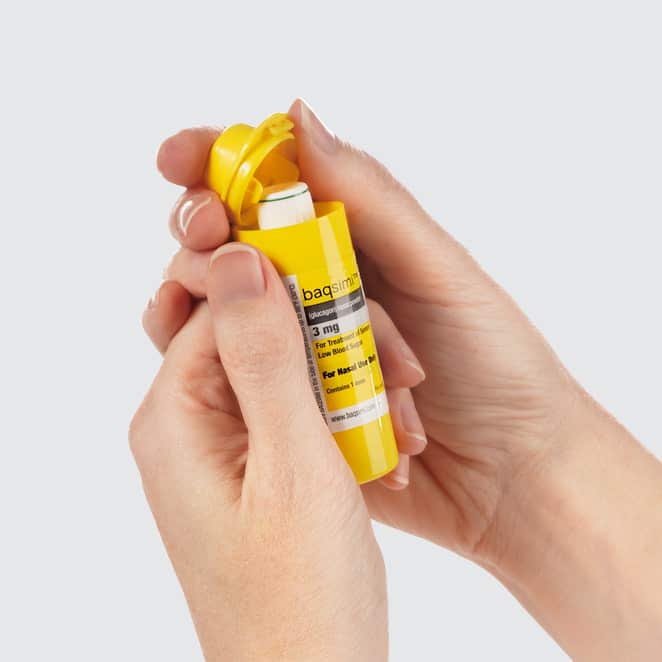
3. Giving the Dose
Hold the device between your fingers and thumb. Don’t push the plunger yet.
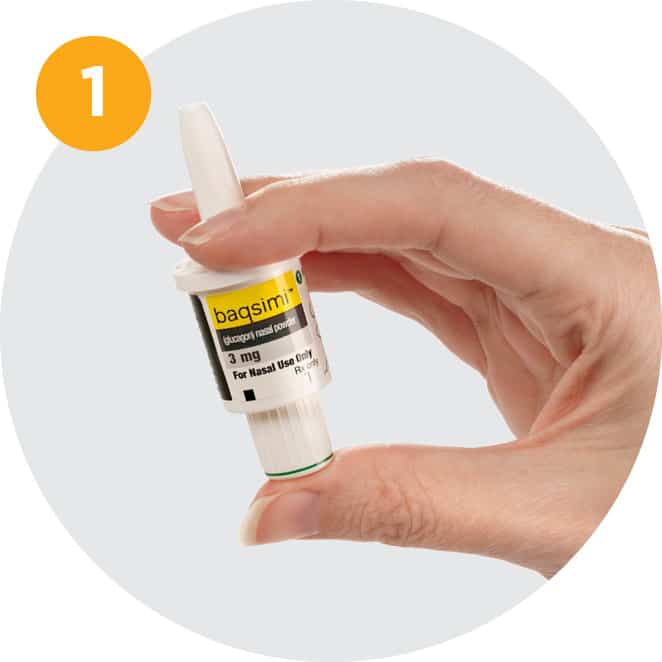
Insert the tip gently into one nostril until your finger touches the outside of the nose.
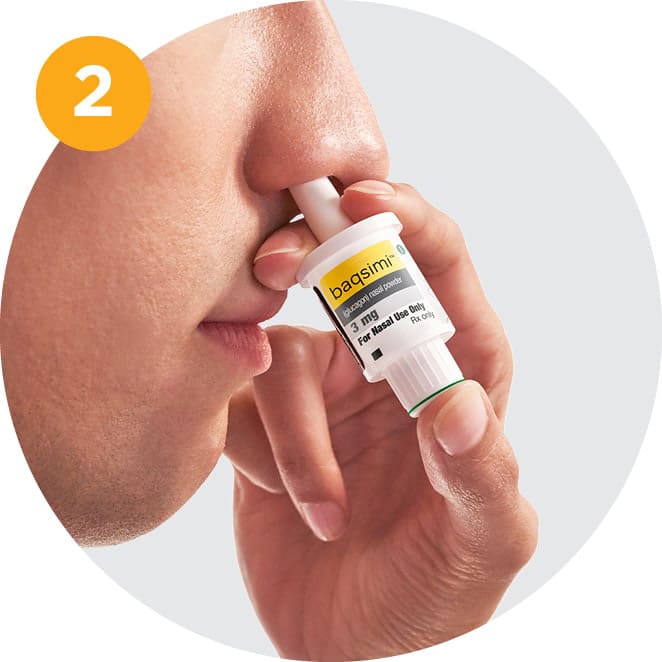
Push the plunger firmly all the way in. The dose is complete when the green line disappears.
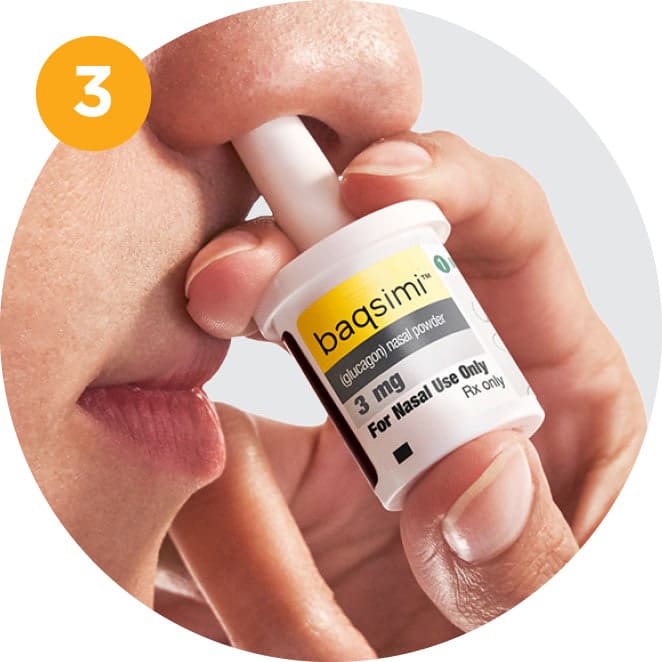
Only one dose of Baqsimi is needed initially. The device delivers the full 3 mg dose of glucagon through the nasal passage to raise glucose levels.
Actions to Take After Administration
Call for emergency medical help immediately after giving Baqsimi nasal spray. Turn the person on their side if they are unconscious to prevent choking.
Throw away the used device and tube right after use. Encourage the person to eat as soon as possible when they can safely swallow.
Post-Administration Care:
- Give fast-acting sugar like juice when they’re alert
- Provide a snack such as crackers with cheese or peanut butter
- Monitor blood sugar levels closely
- Replace the used Baqsimi device immediately
The person should start feeling better within 15 minutes as their glucose levels rise. Stay with them until emergency medical help arrives or they fully recover.
What to Do If There’s No Response
Give another dose of Baqsimi if the person does not respond after 15 minutes and you have a second device available. Use the same administration steps for the second dose.
Continue calling for emergency medical help if you haven’t already. Keep the person on their side if they remain unconscious.
Do not give insulin during hypoglycemia episodes. Monitor their breathing and pulse while waiting for medical assistance to arrive.
If blood sugar levels don’t improve after two doses, additional medical intervention will be needed. Emergency responders can provide intravenous glucose or other treatments to raise glucose levels safely.
When to Use Baqsimi
You should use Baqsimi only during severe hypoglycemia emergencies. This happens when blood sugar drops to dangerously low levels and the person cannot treat themselves. Severe hypoglycemia is often caused by too much insulin, which can lead to dangerously low blood sugar. Baqsimi is used to counteract this effect.
Signs of severe low blood sugar include:
- Loss of consciousness
- Seizures
- Inability to swallow safely
- Severe confusion or disorientation
Baqsimi is intended for use in very low blood sugar emergencies. Do not give insulin during this time.
The medication works for people with diabetes who take insulin or other blood sugar medications. To increase blood sugar levels, Baqsimi must be used as soon as possible once severe hypoglycemia symptoms appear.
You do not need to inhale the powder. Simply spray it into one nostril and the medication will work.
How Baqsimi Treats Severe Hypoglycemia
Baqsimi works by activating glucagon receptors in the liver. This process stimulates the breakdown of stored glycogen into glucose.
The liver then releases this glucose directly into your bloodstream. This quickly raises your blood glucose levels during the emergency.
The Process:
- Glucagon enters your system through nasal tissues
- Receptors in your liver activate
- Stored glycogen breaks down into glucose
- Blood sugar levels rise within minutes
The medication typically starts working within 15 minutes of administration. If the person does not respond after 15 minutes, you may give another dose if available.
Baqsimi works even if you have a cold or are taking cold medicine. The nasal spray does not depend on your ability to breathe through your nose to be effective.
Recognizing Severe Low Blood Sugar
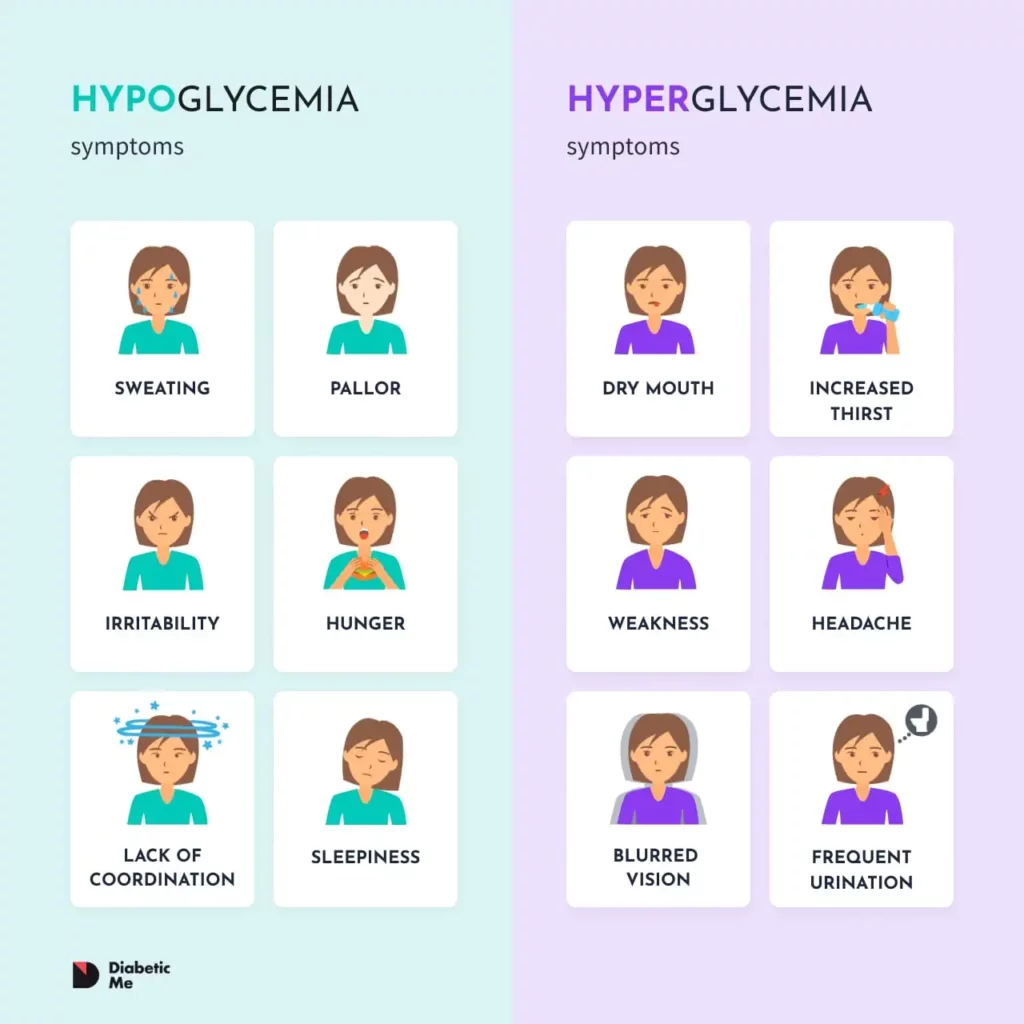
Severe hypoglycemia requires immediate recognition and treatment because symptoms can progress rapidly from mild confusion to loss of consciousness. Understanding the warning signs helps you and your caregivers respond quickly when blood sugar drops to dangerous levels.
Symptoms of Severe Hypoglycemia
Severe low blood sugar creates an emergency situation where you need help from someone else to recover. Unlike mild hypoglycemia, you cannot treat this condition yourself by eating or drinking.
Physical symptoms include shaking, sweating, and dizziness. Your body may feel weak or unsteady as glucose levels drop below safe ranges.
Mental symptoms are often more serious. You may experience difficulty thinking clearly or speaking normally. Confusion and irritability are common warning signs.
Severe symptoms require immediate action. These include:
- Loss of coordination
- Inability to swallow safely
- Seizures
- Loss of consciousness
Blood sugar levels define different emergency stages. Mild hypoglycemia occurs between 54-70 mg/dL. Moderate hypoglycemia happens below 54 mg/dL.
Severe hypoglycemia has no specific blood sugar number. It is defined by your need for help from another person to recover safely.
Potential Side Effects and Interactions
Baqsimi can cause several side effects, with nausea, vomiting, and headache being the most common reactions. The nasal spray also creates specific nose and eye symptoms, and certain medications may interact with its effects.
Common Reactions After Use
The most frequent side effects happen in many people who use Baqsimi. Nausea affects about 26% of adults, making it the top reported reaction.
Most Common Side Effects:
- Nausea (26% of users)
- Headache (18% of users)
- Vomiting (15% of users)
These reactions usually start soon after using the spray. They happen because glucagon affects your digestive system and blood vessels.
In children, vomiting occurs more often than nausea. About 31% of kids experience vomiting compared to 17% who get nauseous.
The symptoms are temporary. They typically go away within a few hours as the medication leaves your system.
Nasal and Respiratory Effects
Since Baqsimi goes directly into your nose, it causes local reactions in most users. These nasal and eye symptoms are very common but usually mild.
Nasal Symptoms You May Experience:
- Runny nose (35% of users)
- Nasal congestion (43% of users)
- Stuffy nose
- Nasal itching (39% of users)
- Discomfort in your nose
Eye-Related Effects:
- Watery eyes (59% of users)
- Red eyes (25% of users)
- Itchy eyes (22% of users)
You might also get sneezing or throat itching. These reactions happen because the powder irritates the tissues in your nose and connected areas.
The effects usually feel uncomfortable but are not dangerous. They should improve within hours of using Baqsimi.
Allergic Reactions and Rare Side Effects
Serious allergic reactions to Baqsimi are uncommon but can be life-threatening. These include rash, breathing problems, and low blood pressure.
Signs of Allergic Reactions:
- Skin rash or hives
- Swelling of face, tongue, or throat
- Trouble breathing
- Severe dizziness
You should not use Baqsimi if you have had allergic reactions to glucagon before. Call 911 (112) right away if you notice any of these serious symptoms.
Other rare side effects include changes in taste, itching, fast heart rate, and high blood pressure. Some people also experience increased blood pressure, especially those with certain medical conditions.
Baqsimi can cause a dangerous increase in blood pressure in people with pheochromocytoma, a rare tumor of the adrenal glands.
Drug Interactions and Precautions
Several medications can change how Baqsimi works or increase side effects. Beta-blockers like atenolol and propranolol may cause temporary increases in heart rate and blood pressure when used with Baqsimi.
Important Drug Interactions:
| Medication Type | Examples | Potential Effect |
|---|---|---|
| Beta-blockers | Atenolol, propranolol | Higher heart rate and blood pressure |
| Blood thinners | Warfarin | Increased bleeding risk |
| Anti-inflammatory drugs | Indomethacin | Reduced effectiveness of Baqsimi |
Warfarin users may have stronger blood-thinning effects, which could increase bleeding risk. Your doctor may need to check your blood more often.
Indomethacin can make Baqsimi less effective at raising blood sugar. This could be dangerous during severe low blood sugar episodes.
Tell your healthcare provider about all medications you take. This includes prescription drugs, over-the-counter medicines, and supplements.
Frequently Asked Questions
What are the step-by-step instructions for administering Baqsimi nasal spray?
Remove the shrink wrap by pulling on the red stripe. Open the lid and take the device out of the tube.
Hold the device between your fingers and thumb. Do not press the plunger yet.
Insert the tip gently into one nostril until your finger touches the outside of the nose. Push the plunger firmly all the way in.
The dose is complete when the green line disappears. Call for emergency medical help right away after giving the dose.
After administering Baqsimi, what is the expected increase in blood sugar levels?
Baqsimi contains glucagon, which tells the liver to release stored sugar into the bloodstream. Blood sugar levels typically start to rise within 15 minutes of giving the dose.
If the person does not respond after 15 minutes, you can give another dose if you have one available. The medication works by triggering the body's natural process of releasing glucose.
What are the proper dosing instructions for Baqsimi nasal spray during an emergency?
Baqsimi contains one complete dose in each device. You give the entire contents of one device into one nostril.
The device cannot be reused after you press the plunger. If you need a second dose, you must use a new device after waiting 15 minutes.
Do not test the device before an emergency because it only works once. Keep extra devices available in case you need them.
Sources
At Diabetic Me, we are committed to delivering information that is precise, accurate, and pertinent. Our articles are supported by verified data from research papers, prestigious organizations, academic institutions, and medical associations to guarantee the integrity and relevance of the information we provide. You can learn more about our process and team on the about us page.

hey Ely Fornoville, was reading about that Baqsimi stuff, sounds neat but kinda confused, how fast does this kick in? got a buddy who’s diabetic and this seems way easier than a shot, but not sure if it works as quick. anyone know?
Hey Ricky, it actually works quite fast. It’s designed to treat severe hypoglycemia pretty quickly because it doesn’t need to be injected. Super useful for emergency situations!
Tess, so you’re saying I can keep hitting the gym without worrying about shots? Sign me up!